Effects of Industrialization on American Society and Native Americans
VerifiedAdded on 2023/05/30
|5
|1088
|263
AI Summary
This essay discusses the consequences and effects of industrialization on American society, politics, and the economy, with a focus on Native Americans. It examines the positive and negative effects of industrialization on females and the standard working citizens, including changes in living standards, consumer products, and the shift to cities. The essay also discusses the establishment of labour unions and the impact of large new business forms on workplaces or factories.
Contribute Materials
Your contribution can guide someone’s learning journey. Share your
documents today.
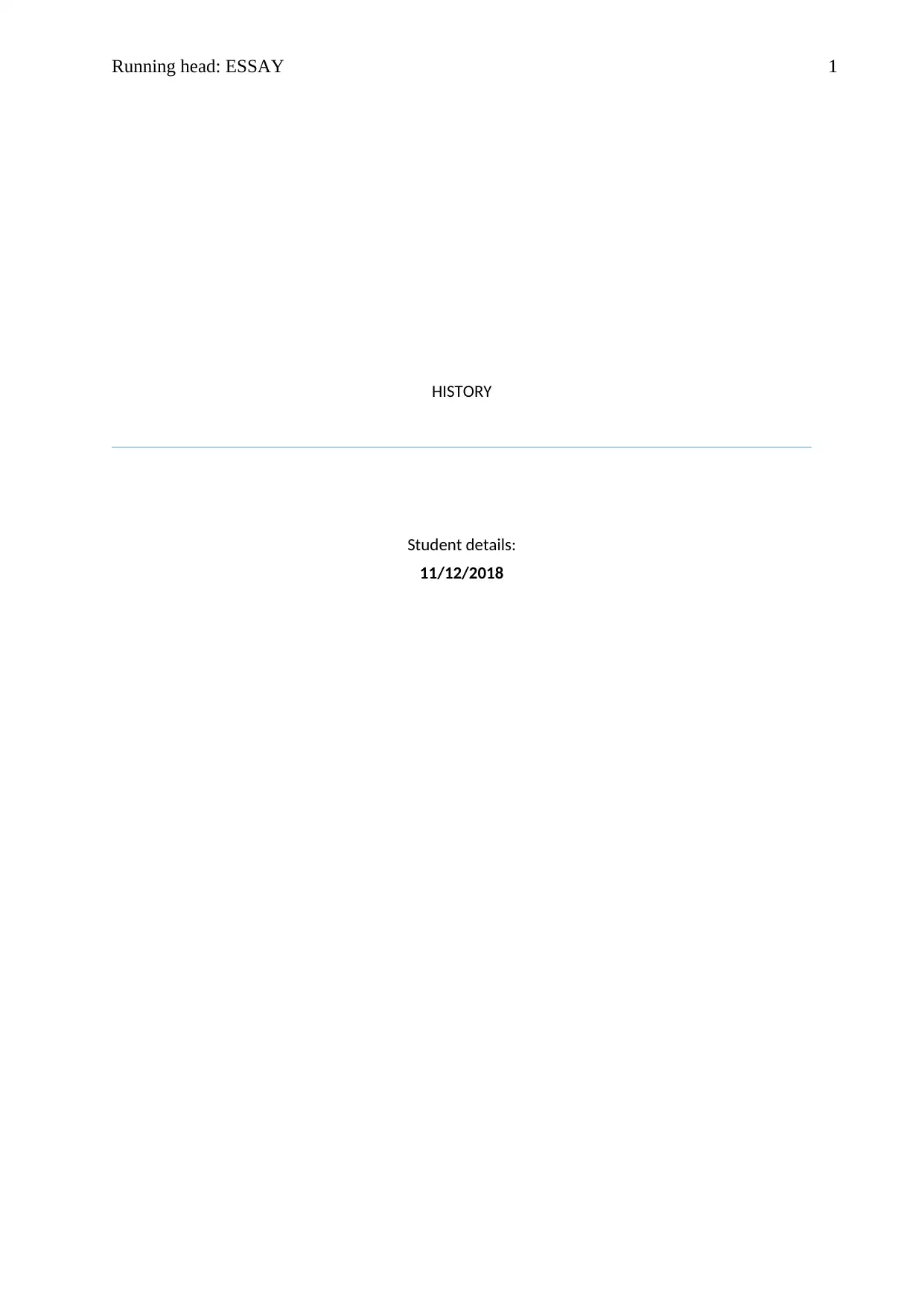
Running head: ESSAY 1
HISTORY
Student details:
11/12/2018
HISTORY
Student details:
11/12/2018
Secure Best Marks with AI Grader
Need help grading? Try our AI Grader for instant feedback on your assignments.
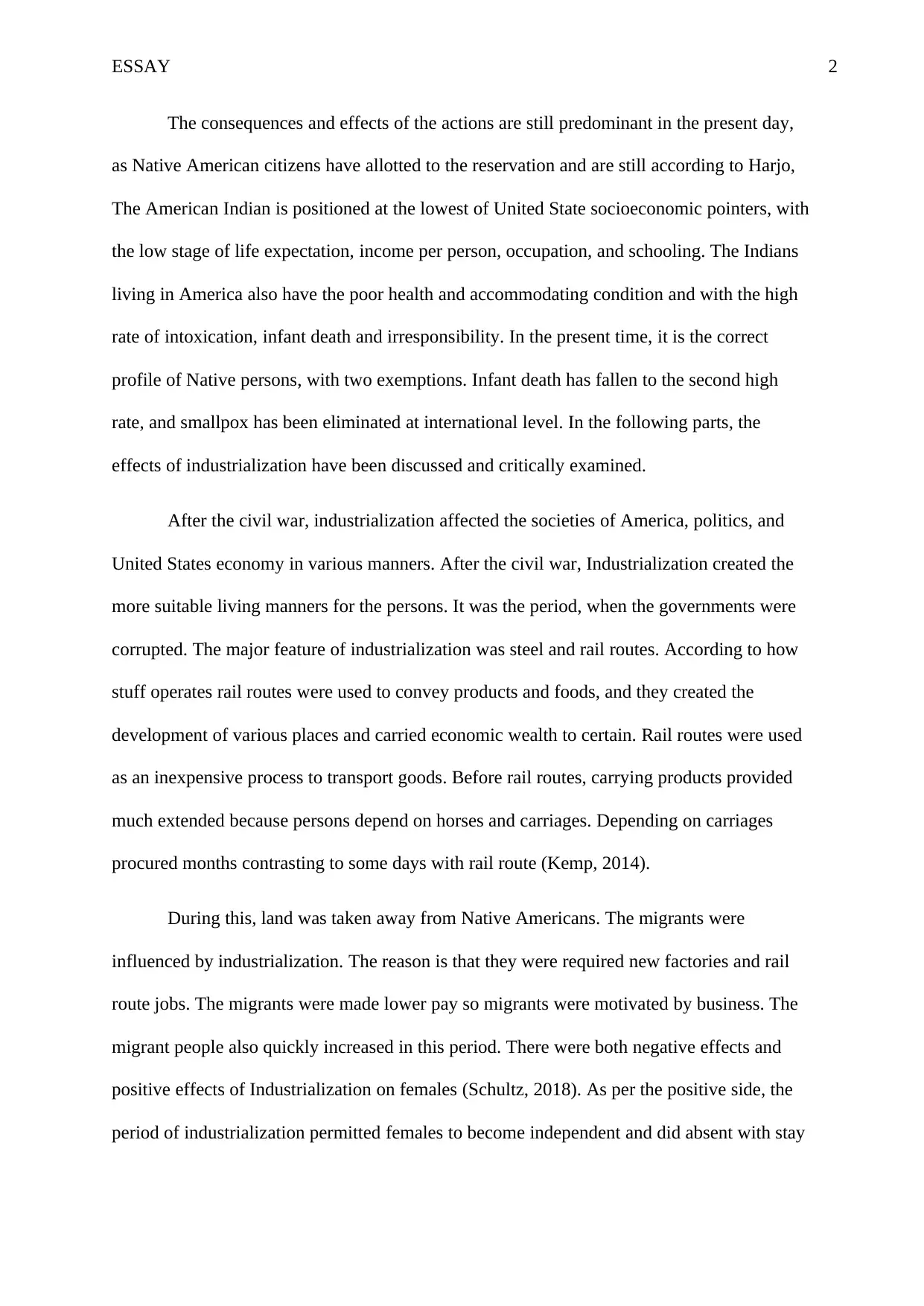
ESSAY 2
The consequences and effects of the actions are still predominant in the present day,
as Native American citizens have allotted to the reservation and are still according to Harjo,
The American Indian is positioned at the lowest of United State socioeconomic pointers, with
the low stage of life expectation, income per person, occupation, and schooling. The Indians
living in America also have the poor health and accommodating condition and with the high
rate of intoxication, infant death and irresponsibility. In the present time, it is the correct
profile of Native persons, with two exemptions. Infant death has fallen to the second high
rate, and smallpox has been eliminated at international level. In the following parts, the
effects of industrialization have been discussed and critically examined.
After the civil war, industrialization affected the societies of America, politics, and
United States economy in various manners. After the civil war, Industrialization created the
more suitable living manners for the persons. It was the period, when the governments were
corrupted. The major feature of industrialization was steel and rail routes. According to how
stuff operates rail routes were used to convey products and foods, and they created the
development of various places and carried economic wealth to certain. Rail routes were used
as an inexpensive process to transport goods. Before rail routes, carrying products provided
much extended because persons depend on horses and carriages. Depending on carriages
procured months contrasting to some days with rail route (Kemp, 2014).
During this, land was taken away from Native Americans. The migrants were
influenced by industrialization. The reason is that they were required new factories and rail
route jobs. The migrants were made lower pay so migrants were motivated by business. The
migrant people also quickly increased in this period. There were both negative effects and
positive effects of Industrialization on females (Schultz, 2018). As per the positive side, the
period of industrialization permitted females to become independent and did absent with stay
The consequences and effects of the actions are still predominant in the present day,
as Native American citizens have allotted to the reservation and are still according to Harjo,
The American Indian is positioned at the lowest of United State socioeconomic pointers, with
the low stage of life expectation, income per person, occupation, and schooling. The Indians
living in America also have the poor health and accommodating condition and with the high
rate of intoxication, infant death and irresponsibility. In the present time, it is the correct
profile of Native persons, with two exemptions. Infant death has fallen to the second high
rate, and smallpox has been eliminated at international level. In the following parts, the
effects of industrialization have been discussed and critically examined.
After the civil war, industrialization affected the societies of America, politics, and
United States economy in various manners. After the civil war, Industrialization created the
more suitable living manners for the persons. It was the period, when the governments were
corrupted. The major feature of industrialization was steel and rail routes. According to how
stuff operates rail routes were used to convey products and foods, and they created the
development of various places and carried economic wealth to certain. Rail routes were used
as an inexpensive process to transport goods. Before rail routes, carrying products provided
much extended because persons depend on horses and carriages. Depending on carriages
procured months contrasting to some days with rail route (Kemp, 2014).
During this, land was taken away from Native Americans. The migrants were
influenced by industrialization. The reason is that they were required new factories and rail
route jobs. The migrants were made lower pay so migrants were motivated by business. The
migrant people also quickly increased in this period. There were both negative effects and
positive effects of Industrialization on females (Schultz, 2018). As per the positive side, the
period of industrialization permitted females to become independent and did absent with stay
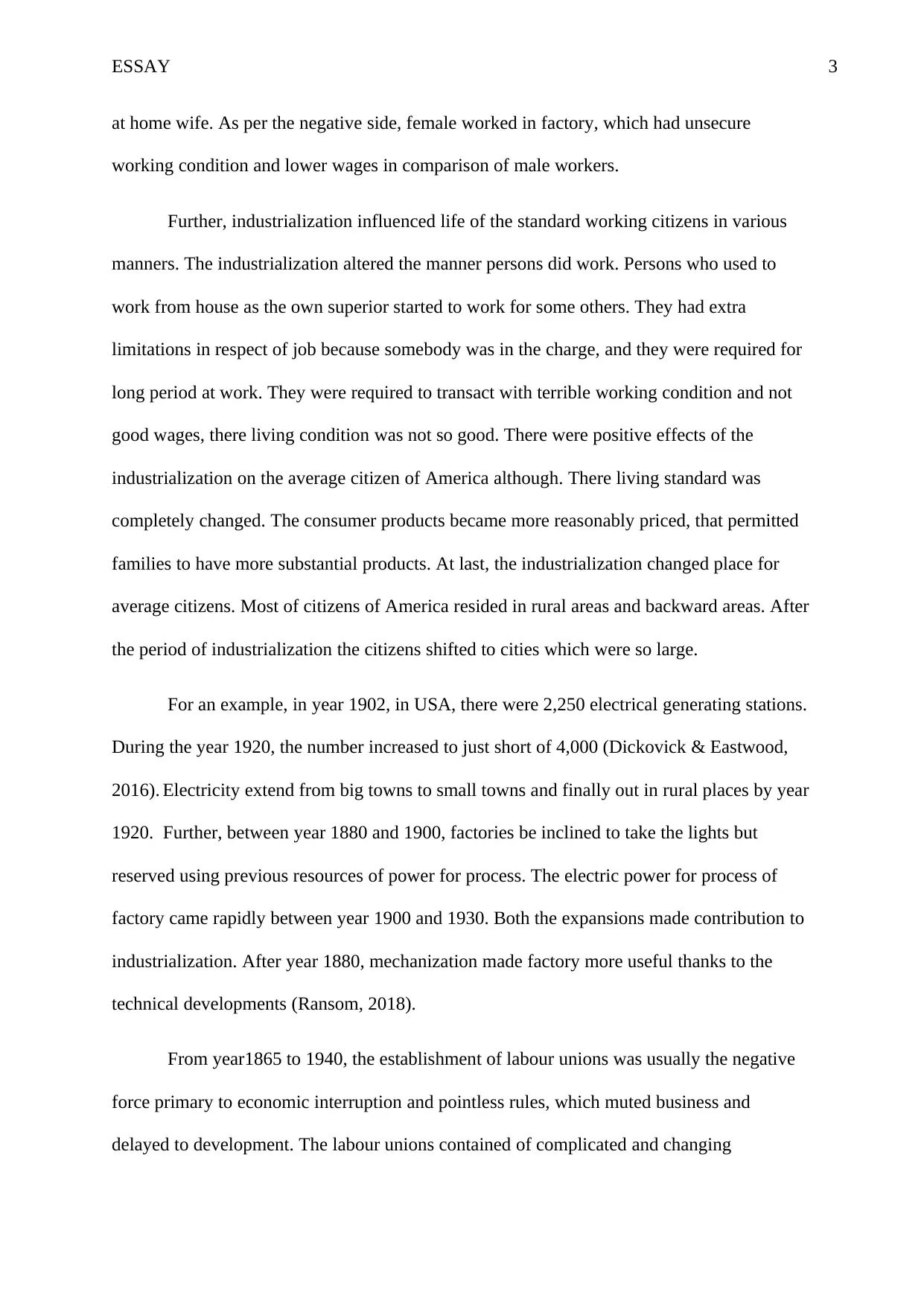
ESSAY 3
at home wife. As per the negative side, female worked in factory, which had unsecure
working condition and lower wages in comparison of male workers.
Further, industrialization influenced life of the standard working citizens in various
manners. The industrialization altered the manner persons did work. Persons who used to
work from house as the own superior started to work for some others. They had extra
limitations in respect of job because somebody was in the charge, and they were required for
long period at work. They were required to transact with terrible working condition and not
good wages, there living condition was not so good. There were positive effects of the
industrialization on the average citizen of America although. There living standard was
completely changed. The consumer products became more reasonably priced, that permitted
families to have more substantial products. At last, the industrialization changed place for
average citizens. Most of citizens of America resided in rural areas and backward areas. After
the period of industrialization the citizens shifted to cities which were so large.
For an example, in year 1902, in USA, there were 2,250 electrical generating stations.
During the year 1920, the number increased to just short of 4,000 (Dickovick & Eastwood,
2016). Electricity extend from big towns to small towns and finally out in rural places by year
1920. Further, between year 1880 and 1900, factories be inclined to take the lights but
reserved using previous resources of power for process. The electric power for process of
factory came rapidly between year 1900 and 1930. Both the expansions made contribution to
industrialization. After year 1880, mechanization made factory more useful thanks to the
technical developments (Ransom, 2018).
From year1865 to 1940, the establishment of labour unions was usually the negative
force primary to economic interruption and pointless rules, which muted business and
delayed to development. The labour unions contained of complicated and changing
at home wife. As per the negative side, female worked in factory, which had unsecure
working condition and lower wages in comparison of male workers.
Further, industrialization influenced life of the standard working citizens in various
manners. The industrialization altered the manner persons did work. Persons who used to
work from house as the own superior started to work for some others. They had extra
limitations in respect of job because somebody was in the charge, and they were required for
long period at work. They were required to transact with terrible working condition and not
good wages, there living condition was not so good. There were positive effects of the
industrialization on the average citizen of America although. There living standard was
completely changed. The consumer products became more reasonably priced, that permitted
families to have more substantial products. At last, the industrialization changed place for
average citizens. Most of citizens of America resided in rural areas and backward areas. After
the period of industrialization the citizens shifted to cities which were so large.
For an example, in year 1902, in USA, there were 2,250 electrical generating stations.
During the year 1920, the number increased to just short of 4,000 (Dickovick & Eastwood,
2016). Electricity extend from big towns to small towns and finally out in rural places by year
1920. Further, between year 1880 and 1900, factories be inclined to take the lights but
reserved using previous resources of power for process. The electric power for process of
factory came rapidly between year 1900 and 1930. Both the expansions made contribution to
industrialization. After year 1880, mechanization made factory more useful thanks to the
technical developments (Ransom, 2018).
From year1865 to 1940, the establishment of labour unions was usually the negative
force primary to economic interruption and pointless rules, which muted business and
delayed to development. The labour unions contained of complicated and changing
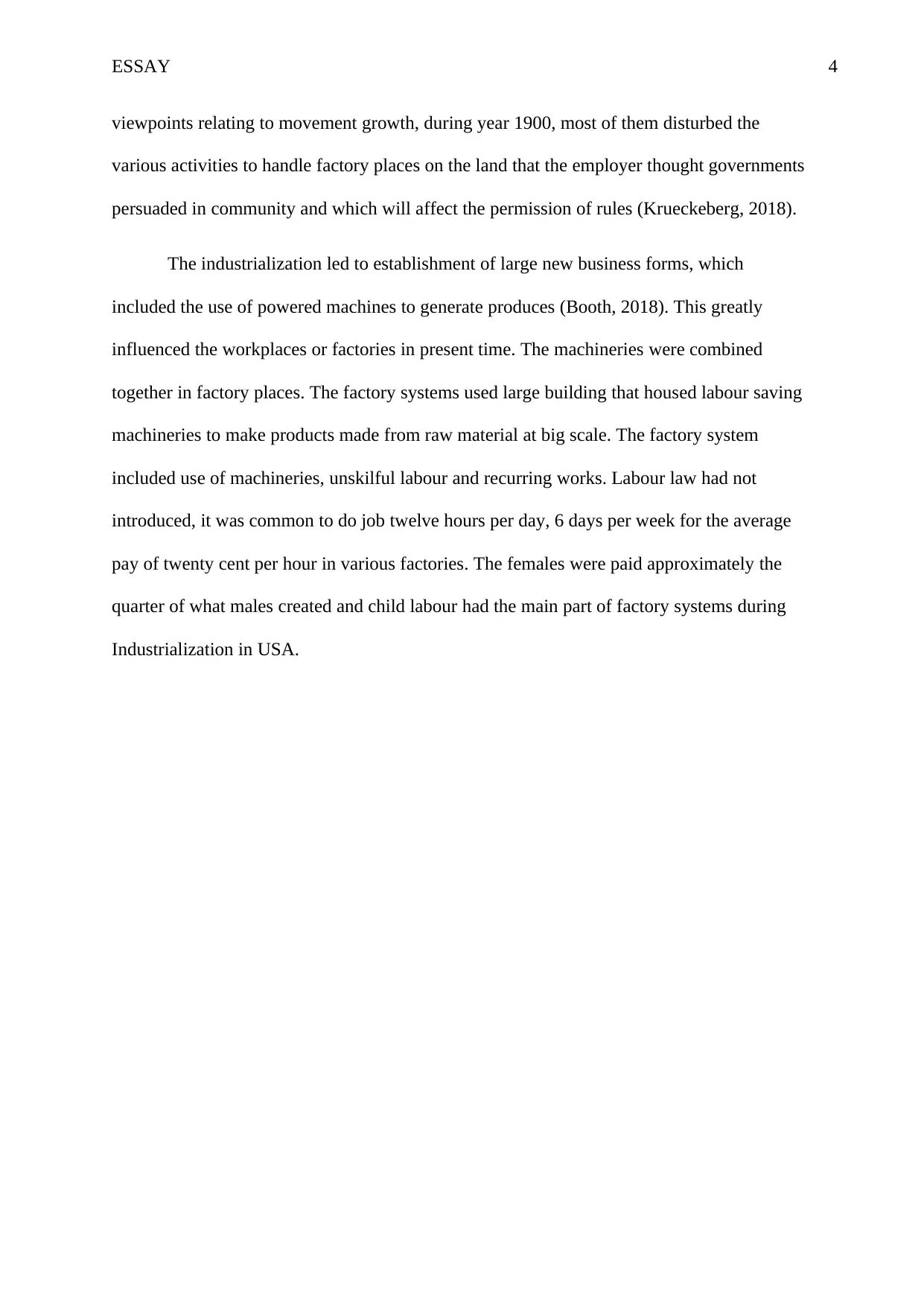
ESSAY 4
viewpoints relating to movement growth, during year 1900, most of them disturbed the
various activities to handle factory places on the land that the employer thought governments
persuaded in community and which will affect the permission of rules (Krueckeberg, 2018).
The industrialization led to establishment of large new business forms, which
included the use of powered machines to generate produces (Booth, 2018). This greatly
influenced the workplaces or factories in present time. The machineries were combined
together in factory places. The factory systems used large building that housed labour saving
machineries to make products made from raw material at big scale. The factory system
included use of machineries, unskilful labour and recurring works. Labour law had not
introduced, it was common to do job twelve hours per day, 6 days per week for the average
pay of twenty cent per hour in various factories. The females were paid approximately the
quarter of what males created and child labour had the main part of factory systems during
Industrialization in USA.
viewpoints relating to movement growth, during year 1900, most of them disturbed the
various activities to handle factory places on the land that the employer thought governments
persuaded in community and which will affect the permission of rules (Krueckeberg, 2018).
The industrialization led to establishment of large new business forms, which
included the use of powered machines to generate produces (Booth, 2018). This greatly
influenced the workplaces or factories in present time. The machineries were combined
together in factory places. The factory systems used large building that housed labour saving
machineries to make products made from raw material at big scale. The factory system
included use of machineries, unskilful labour and recurring works. Labour law had not
introduced, it was common to do job twelve hours per day, 6 days per week for the average
pay of twenty cent per hour in various factories. The females were paid approximately the
quarter of what males created and child labour had the main part of factory systems during
Industrialization in USA.
Secure Best Marks with AI Grader
Need help grading? Try our AI Grader for instant feedback on your assignments.
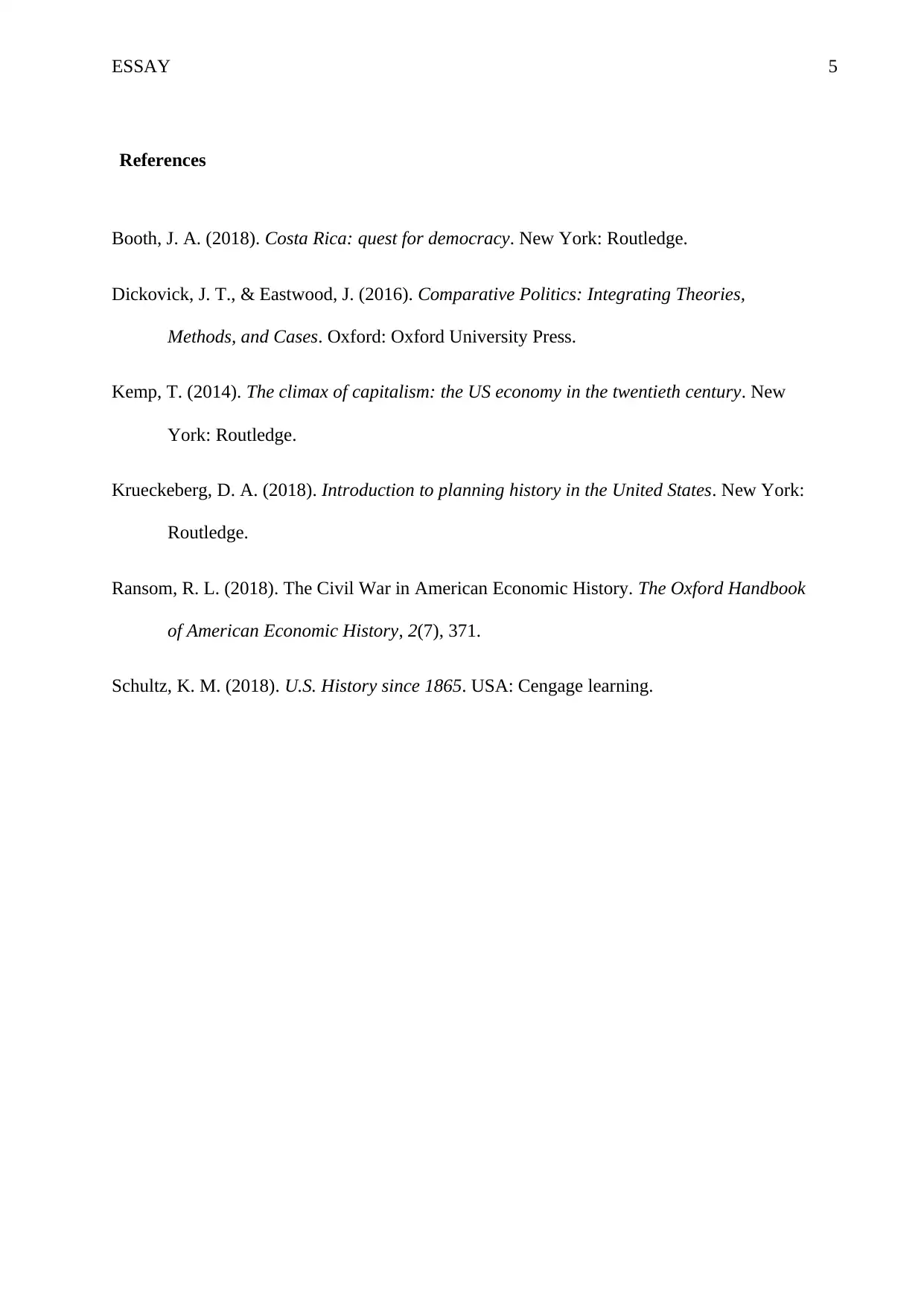
ESSAY 5
References
Booth, J. A. (2018). Costa Rica: quest for democracy. New York: Routledge.
Dickovick, J. T., & Eastwood, J. (2016). Comparative Politics: Integrating Theories,
Methods, and Cases. Oxford: Oxford University Press.
Kemp, T. (2014). The climax of capitalism: the US economy in the twentieth century. New
York: Routledge.
Krueckeberg, D. A. (2018). Introduction to planning history in the United States. New York:
Routledge.
Ransom, R. L. (2018). The Civil War in American Economic History. The Oxford Handbook
of American Economic History, 2(7), 371.
Schultz, K. M. (2018). U.S. History since 1865. USA: Cengage learning.
References
Booth, J. A. (2018). Costa Rica: quest for democracy. New York: Routledge.
Dickovick, J. T., & Eastwood, J. (2016). Comparative Politics: Integrating Theories,
Methods, and Cases. Oxford: Oxford University Press.
Kemp, T. (2014). The climax of capitalism: the US economy in the twentieth century. New
York: Routledge.
Krueckeberg, D. A. (2018). Introduction to planning history in the United States. New York:
Routledge.
Ransom, R. L. (2018). The Civil War in American Economic History. The Oxford Handbook
of American Economic History, 2(7), 371.
Schultz, K. M. (2018). U.S. History since 1865. USA: Cengage learning.
1 out of 5
Your All-in-One AI-Powered Toolkit for Academic Success.
+13062052269
info@desklib.com
Available 24*7 on WhatsApp / Email
![[object Object]](/_next/static/media/star-bottom.7253800d.svg)
Unlock your academic potential
© 2024 | Zucol Services PVT LTD | All rights reserved.